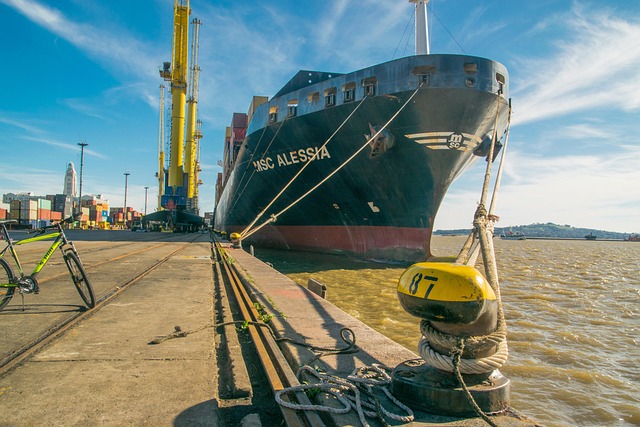Shipping containers come in standard sizes, primarily 20ft and 40ft, regulated by ISO. While external measurements for a 40ft container are approximately 40ft x 8ft x 8.5ft, internal dimensions offer slightly less usable space due to structural elements. The 40ft high cube container provides enhanced vertical clearance and optimized stacking for bulk cargo or palleted goods. Understanding shipping container dimensions is crucial for optimizing space utilization during loading and unloading processes, particularly in logistics and supply chain management. A comprehensive dimension guide, available in metric or imperial units, is essential for efficient use of any container size or type.
“Unleash the potential of your cargo with a deep dive into the 40-foot shipping container interior dimensions and usable cargo space. In this comprehensive guide, we demystify standard shipping container sizes, providing insights into calculating every inch of usable space. From maximizing interior layout to efficient load organization, we explore key considerations for optimal utilization. Discover creative designs and best practices for securing your cargo, transforming these containers into versatile, functional spaces—all while focusing on the crucial aspect of shipping container dimensions.”
- Understanding Standard Shipping Container Sizes
- Calculating Usable Cargo Space Within a 40-Foot Container
- Key Considerations for Maximizing Interior Space
- Common Layouts and Design Ideas for Container Conversions
- Best Practices for Efficient Load Organization and Security
Understanding Standard Shipping Container Sizes

Shipping containers come in various sizes, each with specific internal dimensions tailored to different cargo needs and application requirements. Understanding these standard shipping container sizes is crucial for optimizing space utilization and ensuring efficient loading and unloading processes. The two most common types are the 20-foot (6.1 meters) and 40-foot (12.2 meters) containers, both of which serve as industry standards worldwide. These dimensions are regulated by organizations like ISO (International Organization for Standardization), ensuring compatibility across different container manufacturers and owners.
The internal dimensions of a shipping container, including the 20ft and 40ft varieties, differ from its external measurements. For instance, a standard 40-foot container has an exterior length of approximately 40 feet (12.2 meters), width of 8 feet (2.44 meters), and height of 8.5 feet (2.60 meters). However, the usable cargo space is slightly less due to factors like the door opening dimensions, internal framing, and ceiling clearance. The interior dimensions for a 40-foot high cube container, for example, offer more vertical clearance and are optimized for efficient stacking and loading of goods, making it suitable for bulk cargo or palleted items.
Calculating Usable Cargo Space Within a 40-Foot Container

Key Considerations for Maximizing Interior Space

When optimizing the interior space of a shipping container, several key considerations come into play, especially given the uniform external dimensions that define these versatile units (ISO container dimensions). The first step is to understand the standard container dimensions for both 20ft and 40ft varieties. This foundation allows you to calculate internal space effectively, keeping in mind crucial factors like shipping container door opening dimensions, floor plans, and ceiling heights.
Maximizing cargo space requires strategic planning. For instance, in a 40ft high cube container (40ft container internal dimensions), utilizing the full height for storage can significantly increase load capacity. Similarly, custom container dimensions or reefer containers (reefer container dimensions) may have unique features that affect interior layout. Flat rack containers (flat rack container dimensions), with their specialized open top, present distinct challenges and opportunities for loading. A shipping container dimension guide, whether in metric or imperial units, is essential to navigate these variables, ensuring your space is used efficiently and safely, regardless of the container size (wide shipping container dimensions, narrow shipping container dimensions) or its intended purpose.
Common Layouts and Design Ideas for Container Conversions

When converting a shipping container into a usable space, understanding its internal dimensions is crucial. For standard 20ft and 40ft containers, the exterior dimensions are well-documented—approximately 8.2 feet wide, 20 or 23 feet long, and 8.5 to 9.5 feet high, respectively. However, it’s the internal dimensions that dictate how much usable cargo space you have. For instance, a standard 40ft container has an interior height of around 7.5 to 8 feet (the exact figure can vary based on specific manufacturer and configuration), offering ample headroom for various purposes.
Common layouts include open-plan spaces for storage or light manufacturing, with sections dedicated to offices, workshops, or even living quarters in the case of tiny homes. Design ideas range from simple and functional to creative and modular, allowing for customization based on the intended use. For example, 20ft high cube containers offer similar internal dimensions to standard 20fters but with a taller ceiling height, suitable for more specialized storage or light industrial applications. Similarly, reefer containers designed for temperature-controlled shipping have specific interior dimensions and door opening sizes tailored to their purpose, while flat rack containers might require custom modifications for oversized cargo.
Best Practices for Efficient Load Organization and Security

Maximizing usable cargo space in a 40-foot shipping container requires careful consideration of efficient load organization and security practices. First, ensure that items are securely fastened and stacked to prevent shifting during transit. Utilize specialized racking systems or pallets to optimize vertical space, especially when dealing with taller or larger goods. Remember that the standard height for a 20ft and 40ft shipping container roof is around 8.5 feet (2.6 meters), leaving limited headroom for bulky items.
Best practices also include organizing loads based on weight distribution to maintain stability. Light items should be placed on top, while heavier pieces should be secured closer to the center of gravity. Consider using labeled and color-coded containers or pallets to easily identify contents at a glance. Additionally, implement robust security measures like lockable cargo nets, chains, or seal systems to deter theft and ensure the integrity of your shipment.
Understanding the interior dimensions of a 40-foot shipping container is key to efficient cargo planning. By grasping the usable cargo space within these standardized vessels, individuals and businesses can optimize their logistics and design innovative solutions for various applications. This article has provided practical insights into calculating and maximizing this space, considering key factors, exploring conversion layouts, and ensuring secure load organization. Now equipped with this knowledge, readers can navigate the world of shipping containers with enhanced confidence, unlocking the full potential of these versatile structures.
